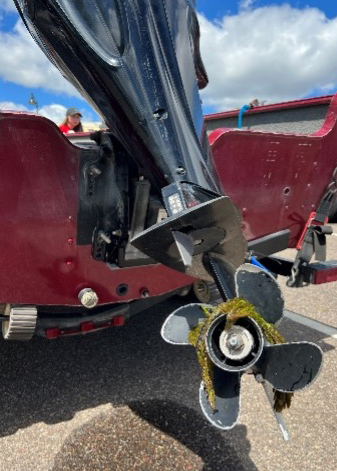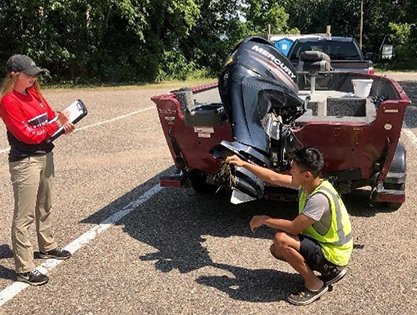by Nichole Angell
If you live in the Great Lakes region, you have more than likely heard of aquatic invasive species (AIS) and the risk they pose to the region’s highly valued water resources. AIS serve as ecosystem engineers negatively impacting the environment, economy, and human health. While invaders like zebra mussels and Eurasian watermilfoil can spread between waterbodies through various pathways, recreational boating is the biggest culprit.

Minnesotans love boating with 1 in 6 Minnesotans owning a boat. Within the state there are over 3,000 public boat launches giving boaters access to over 10,000 lakes. But boaters aren’t the only ones experiencing the variety of lakes the state has to offer, AIS join the journey hitching a ride from lake to lake attached or entangled on boats and boating equipment. Over land transport of AIS via boats allows a variety of invasive aquatic pests to be introduced to new waterbodies where they thrive by outcompeting native species for food and resources. Many Minnesotans realize that action must be taken to combat the spread of detrimental AIS.
Learning to manage AIS is no easy feat, however the state of Minnesota is a leader in this effort with over 10 million dollars in state funds being allocated to AIS interventions every single year. While funding is essential to accomplishing the state’s AIS management goals, success isn’t guaranteed, especially if managers don’t have knowledge on how to best spend that funding.
What managers do know is that prevention is the most cost-effective form of intervention because it stops invaders from being introduced in the first place saving millions of dollars in maintenance and control costs down the road. However, there are many prevention options to choose from including boater education, watercraft inspection and hot water decontamination. Boater education entails teaching boaters best management practices like “cleaning, draining, and drying” their boats before leaving a boat launch. Watercraft inspection involves training inspectors to examine and remove AIS from boats at boat launches. A hot water decontamination is completed on a boat if an AIS cannot be removed by hand and a decontaminator utilizes hot water and high pressure to kill and removed the persistent AIS. While the state commonly spends money implementing these three preventions across the landscape, it is not fully understood how the effectiveness each of these techniques compares to the next.

Researchers at the Minnesota Aquatic Invasive Species Research Center (MAISRC) are working to better understand which AIS prevention techniques will give AIS managers the best bang for their buck. Graduate research assistant, Nichole Angell, spent the summer hosting experimental boat cleaning sessions at boat launches across the state of Minnesota. During these sessions boaters, inspectors, and decontaminators completed prevention steps on a boat that Nichole had realistically staged with AIS prior to the session. By observing participants actions during these sessions, the MAISRC team was able to quantify the AIS removal abilities of each participant and the prevention technique they represented.
While AIS managers aim to implement the most effective AIS preventions, they have to do so under budget constraints, therefore MAISRC researchers wanted to understand not only how effective these preventions were, but also how much they cost. In order to quantify the costs of boater education, watercraft inspection, and hot water decontamination, Nichole sat down and interviewed AIS managers across the state. She gathered itemized spending information to estimate average expenditures on these preventions in question.
With the final stages of this project costs data will be coupled with effectiveness data for each prevention technique in question to inform managers which techniques are worthwhile to implement as part of their prevention plans. With expected completion in summer of 2023, these results will allow managers to choose and utilize their preventions in the most strategic and efficient ways across the landscape saving time, money, and our lakes.